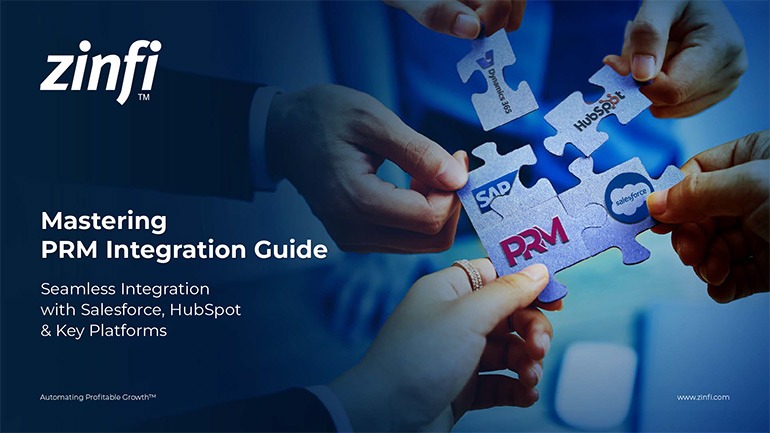Best Practices Articles

The Partner Pod Model: Scaling Partner Marketing for Maximum Impact
As businesses grow, their partner marketing efforts must evolve to meet the increasing demand for efficiency, scalability, and impact. Many companies struggle with fragmented partner engagement, one-off campaigns, and inconsistent co-marketing efforts. The result? Missed opportunities and underutilized partnerships. To address these challenges, companies need a structured approach that fosters continuous collaboration, aligns marketing and sales, and maximizes shared resources.
The Partner Pod Model is an innovative framework designed to scale partner marketing by combining multiple non-competing companies with complementary solutions. Instead of engaging in isolated marketing efforts, brands can collaborate strategically, share audiences, and amplify their demand-generation initiatives. This approach transforms co-marketing strategies from disconnected campaigns into an integrated system that drives sustainable business growth.
This article will explore the Partner Pod Model, its benefits, how to implement it, and how businesses can leverage it to create high-impact partner marketing campaigns. This approach allows companies to scale faster, generate more leads, and improve overall partner engagement.
What is the Partner Pod Model?
The Partner Pod Model is a structured, multi-company alliance where non-competing businesses collaborate to create and execute partner marketing initiatives. Unlike traditional co-marketing efforts that involve occasional joint webinars or blog collaborations, a Partner Pod focuses on continuous engagement, shared resources, and unified demand generation.
Each Partner Pod typically consists of:
- 3-7 Non-Competing Companies– Businesses that serve the same ideal customer profile (ICP) but offer complementary solutions.
- A Dedicated Orchestrator– A partner marketing specialist (internal or external) who manages strategy, execution, and alignment.
- A Shared Go-to-Market Plan– Regular marketing initiatives, including webinars, content marketing, LinkedIn campaigns, and joint sales efforts.
- Integrated Follow-Up Systems– A structured process to ensure lead nurturing and pipeline management across all participating companies.
Partner Pods enhance marketing effectiveness, increase reach, and reduce costs by working together, making them a game-changer for partner marketing strategies.
The Benefits of the Partner Pod Model in Partner Marketing
- Increased Demand Generation with Shared Audiences
One of the most significant advantages of the Partner Pod Model is the ability to tap into multiple partner marketing audiences at once. Each partner in the pod brings its customer base, email list, and social media following, expanding reach exponentially. Instead of relying solely on their marketing channels, companies can co-promote content and events, creating a network effect that amplifies visibility.
For example, if five companies have an email list of 10,000 subscribers, a jointly promoted co-marketing campaign can instantly reach 50,000 potential customers. This shared demand-generation strategy results in higher engagement, better-qualified leads, and improved conversion rates. The key is ensuring all partners are ICP-aligned and that messaging remains relevant to all audiences.
Additionally, joint LinkedIn campaigns, co-branded content, and multi-company events allow partners to build credibility and increase brand authority. A well-executed Partner Pod expands the market reach and drives more high-quality leads than standalone partner marketing efforts.
- Cost Efficiency and Resource Optimization
Traditional partner marketing campaigns often require significant investment in content creation, paid advertising, and event sponsorships. For many businesses, these costs can be prohibitive. The Partner Pod Model solves this by distributing marketing costs among multiple partners, significantly reducing the financial burden on each participant.
Instead of each company running independent campaigns, a Partner Pod can pool resources for content creation, video production, and paid promotions. This shared approach maximizes impact while minimizing individual spending. Companies that previously lacked the budget for large-scale co-marketing initiatives can now participate in high-ROI marketing campaigns at a fraction of the cost.
Moreover, resource sharing extends beyond budgets. Partners can leverage each other’s expertise in areas like SEO, social media marketing, and email automation. By collaborating, companies can access best-in-class marketing strategies without building everything from scratch. This makes the Partner Pod Model ideal for startups and mid-sized companies looking to efficiently scale their partner marketing efforts.
- Stronger Partner Engagement and Sales Alignment
One of the biggest challenges in partner marketing is ensuring ongoing partner engagement and alignment between marketing and sales teams. Many partnerships fail due to inconsistent communication, lack of follow-through, or misaligned incentives. The Partner Pod Model fosters continuous partner enablement, ensuring all stakeholders remain engaged and aligned.
Partner Pods create a seamless collaboration environment by establishing regular touchpoints like monthly strategy meetings, shared Slack channels, and unified CRM integrations. Partners are no longer just occasional marketing allies; they become integrated growth partners working towards shared revenue goals.
Additionally, co-selling becomes more effective when multiple partners collaborate on lead nurturing and follow-up strategies. A unified pipeline management system allows partners to track leads, identify opportunities, and coordinate outreach efforts. This ensures that all leads generated from co-marketing campaigns are appropriately nurtured and converted into sales.
How to Build a Successful Partner Pod for Partner Marketing
Step 1: Identify the Right Partners
Selecting the right partners is critical for a successful Partner Pod. Look for companies that:
- Serve the same ICP but do not directly compete with your business.
- Have a strong marketing presence and the ability to drive traffic.
- Are committed to long-term collaborationand co-marketing efforts.
Conduct an audit of potential partners and assess their audience size, content quality, and overall alignment with your brand’s messaging.
Step 2: Establish a Shared Marketing PlanA successful Partner Pod requires a clear marketing strategy that outlines the following:
- Joint content themes and messaging to ensure consistency.
- Multi-channel promotional tactics (LinkedIn, email, webinars, blogs).
- Lead sharing and follow-up processes to maximize conversion rates.
Develop a shared editorial calendar and assign responsibilities to each partner to ensure even contribution and accountability.
Step 3: Leverage Marketing Automation for ScalabilityTo streamline execution, use marketing automation tools that allow for:
- Automated lead tracking and attribution for all partners.
- Personalized email sequences for different partner audiences.
- AI-powered content distribution across multiple channels.
This enables scalability while maintaining a high level of personalization for potential customers.
Step 4: Measure Performance and Optimize ContinuouslyTrack key partner marketing KPIs such as:
- Engagement rates (email opens, webinar attendance, social shares).
- Lead conversion rates from co-marketing campaigns.
- Revenue impact from Partner Pod initiatives.
Regularly analyze performance data and refine strategies to improve outcomes. A data-driven approach ensures long-term success and higher partner engagement.
Conclusion: Why the Partner Pod Model is the Future of Partner Marketing
The Partner Pod Model represents a fundamental shift in how businesses approach partner marketing. By fostering collaboration, sharing demand-generation efforts, and optimizing resources, this model allows companies to scale their marketing efforts more efficiently.
Businesses that embrace the Partner Pod Model will see the following:
- Higher partner engagement and sales alignment.
- Increased demand generation and lead quality.
- More cost-effective co-marketing strategies.
To scale your partner marketing strategy, consider building a Partner Pod to drive sustained growth and market success.
Best Practices Guidebook
 The Ultimate Guide to Partner Marketing Success Best Practices
The Ultimate Guide to Partner Marketing Success Best PracticesDownload Guide
 How to Start and Scale Partner Ecosystems Best Practices
How to Start and Scale Partner Ecosystems Best PracticesDownload Guide
 The Evolution of PartnerOps: Past, Present & Future Best Practices
The Evolution of PartnerOps: Past, Present & Future Best PracticesDownload Guide
 Mastering Channel Sales: Strategies, Best Practices, and Growth Tactics for 2025
Mastering Channel Sales: Strategies, Best Practices, and Growth Tactics for 2025Download Guide
 Winning with Partner Advisory Councils: Best Practices for Partner Engagement & Growth
Winning with Partner Advisory Councils: Best Practices for Partner Engagement & GrowthDownload Guide
 The Future of Partner Ecosystems Best Practices
The Future of Partner Ecosystems Best PracticesDownload Guide
 The AI Revolution: How Technology and Talent are Shaping the Future
The AI Revolution: How Technology and Talent are Shaping the FutureDownload Guide
 Top 105 Partner Management Metrics that Matter Best Practices
Top 105 Partner Management Metrics that Matter Best PracticesDownload Guide
 Mastering PRM Integration Best Practices
Mastering PRM Integration Best PracticesDownload Guide
 Building a Sales Partner Portal with Salesforce Best Practices
Building a Sales Partner Portal with Salesforce Best PracticesDownload Guide
 Building and Managing Partner Ecosystems Best Practices
Building and Managing Partner Ecosystems Best PracticesDownload Guide
 Mastering Co-Marketing and Co-Selling Best Practices
Mastering Co-Marketing and Co-Selling Best PracticesDownload Guide
 Transforming Partner Ecosystems Best Practices
Transforming Partner Ecosystems Best PracticesDownload Guide
 Mastering Partner Ecosystems Best Practices
Mastering Partner Ecosystems Best PracticesDownload Guide
 Mastering Partner Onboarding Best Practices
Mastering Partner Onboarding Best PracticesDownload Guide
 Partner Ecosystem Management Best Practices
Partner Ecosystem Management Best PracticesDownload Guide
 B2B Marketing in the Age of Intelligence Best Practices
B2B Marketing in the Age of Intelligence Best PracticesDownload Guide
 Multi-Partner Co-Selling Best Practices
Multi-Partner Co-Selling Best PracticesDownload Guide







